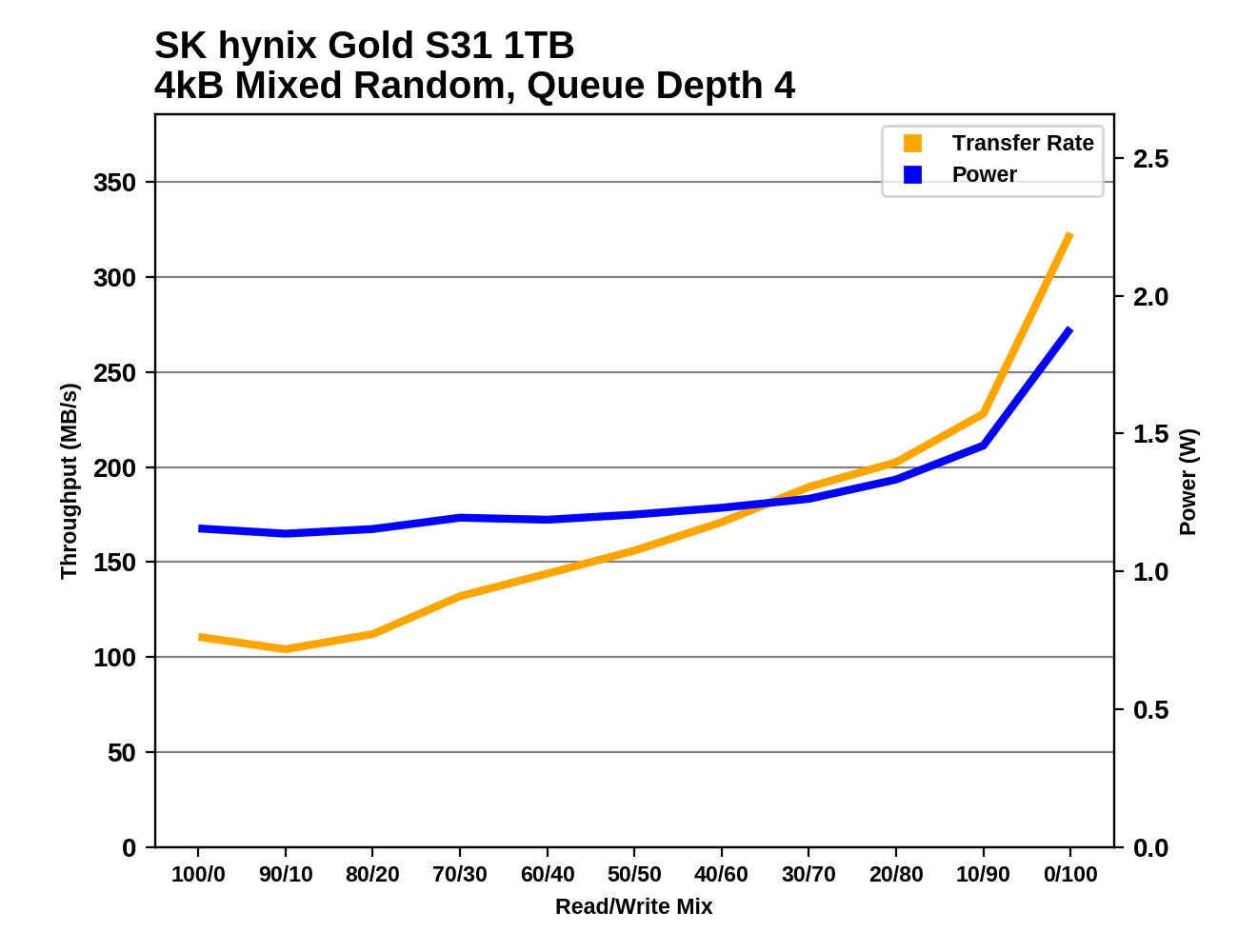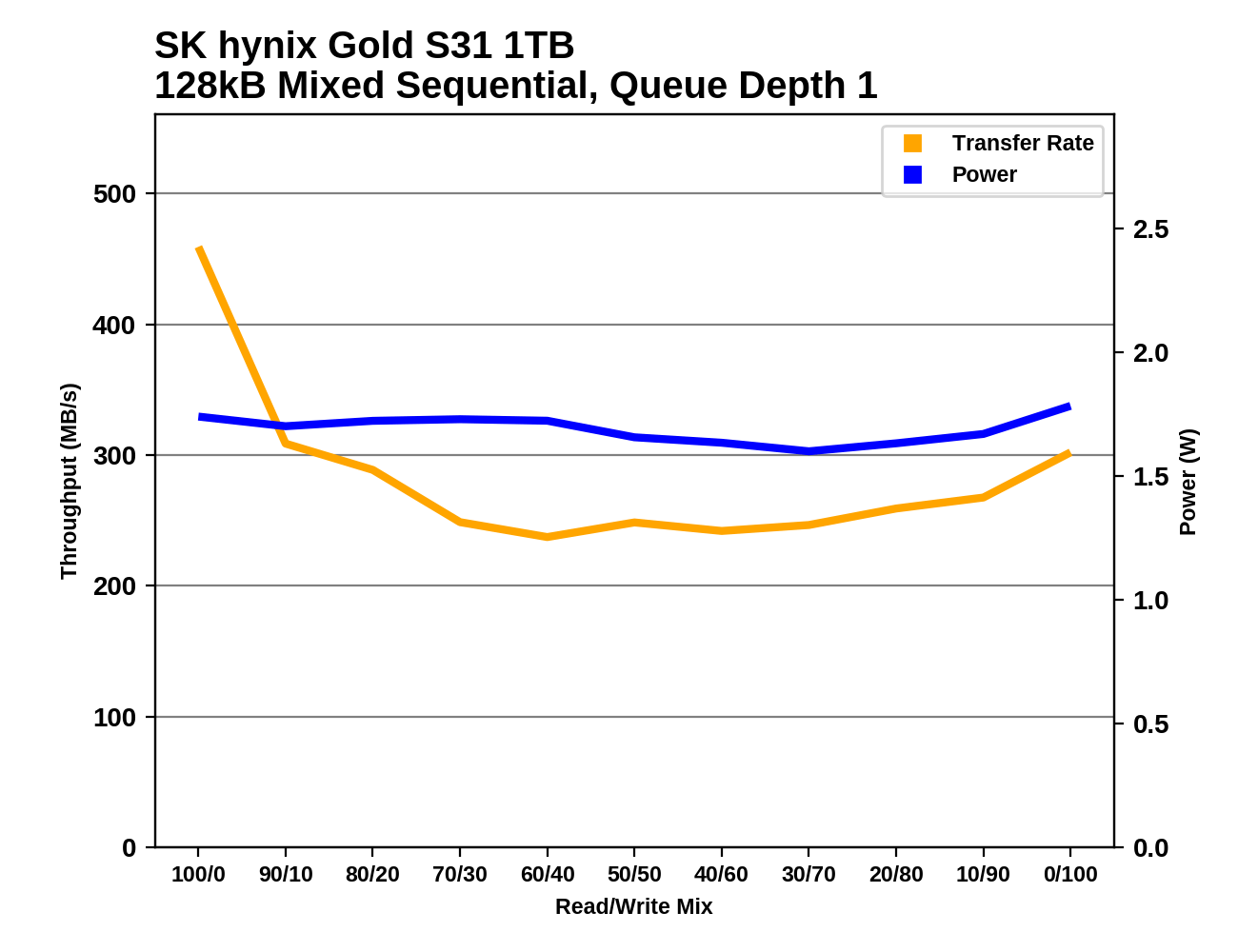The SK Hynix Gold S31 SATA SSD Review: Hynix 3D NAND Finally Shows Up
by Billy Tallis on November 13, 2019 12:00 PM ESTMixed Random Performance
Our test of mixed random reads and writes covers mixes varying from pure reads to pure writes at 10% increments. Each mix is tested for up to 1 minute or 32GB of data transferred. The test is conducted with a queue depth of 4, and is limited to a 64GB span of the drive. In between each mix, the drive is given idle time of up to one minute so that the overall duty cycle is 50%.

All three capacities of the SK Hynix Gold S31 perform fairly well on the mixed random IO test. The 1TB and 500GB models rank just behind their fastest competitors of like capacity, and the 250GB model performs on par with several drives of significantly higher capacity.
 |
|||||||||
| Power Efficiency in MB/s/W | Average Power in W | ||||||||
The three capacities again earn excellent power efficiency scores, second only to Samsung's 860 series drives. In absolute terms, the three are each averaging less power draw than any of the DRAM-equipped drives.
 |
|||||||||
Performance for the S31 on the mixed random IO test increases quickly as the proportion of writes in the workload is increased. As is typical, the test ends with a spike in performance as the workload shifts to 100% cacheable random writes. The 250GB model starts to fall behind after writes account for more than 20% of the workload, and it doesn't really catch up even at the end of the test.
Mixed Sequential Performance
Our test of mixed sequential reads and writes differs from the mixed random I/O test by performing 128kB sequential accesses rather than 4kB accesses at random locations, and the sequential test is conducted at queue depth 1. The range of mixes tested is the same, and the timing and limits on data transfers are also the same as above.

In stark contrast to the good overall performance on the mixed random IO test, the SK Hynix Gold S31 drives are all in the bottom performance tier for the mixed sequential workload test. The 1TB model is basically tied with a DRAMless SSD, and the smaller two are even slower though they outperform the DRAMless drive of similar capacity.
 |
|||||||||
| Power Efficiency in MB/s/W | Average Power in W | ||||||||
Even though performance on the mixed sequential IO test was clearly on the low side, the drives earn power efficiency scores that are only slightly below par. Their power consumption in absolute terms is still a bit lower than most of the competition.
 |
|||||||||
All three capacities of the S31 start out with decent performance with the pure-read workload phase of this test, but performance drops off quickly. The 1TB model spends most of the test hovering around 250MB/s and the 500GB model is a bit slower than that. The 250GB model takes until the 30/70% read/write mix for performance to level out at well under 200 MB/s.










22 Comments
View All Comments
jabber - Friday, November 15, 2019 - link
I think the thing is we are now at the point of diminishing returns. I find it hard to tell the everyday difference between running a desktop on a 550MBps SATA or a 3000MBps NVMe (NVMe was a real disappointment for the boost it gives). 20+ years ago if I got another 5FPS in Quake I could tell. Now if my games jump from 130FPS to 140FPS...meh.I was upgrading my CPU every 6 months at one point many years ago. Now it's lucky if i change it every 6 years...
Samus - Friday, November 15, 2019 - link
Actually a pretty impressive drive. The steady state performance is excellent. When I'm pushing out images to new PC's it's ridiculous a lot of the SSD's bottleneck even the network connection (which is realistically around 160MB/sec via (1Gbps Multicast) as you see it write VERY fast for the first half of a 15GB image then fall off.Imaging over USB 3.0 is totally brutal and only slightly faster than via the network. The SSD's are a mix of Intel OEM 540/545s drives and Micron 1100/1300 OEM drives, depending on the vendor. HP seems to use the Intel and Dell the Micron's. They're such shit all around drives for my job, but as you can imagine the users don't care because they're writing maybe a few GB a day via Outlook OST caching and general paging in Windows.